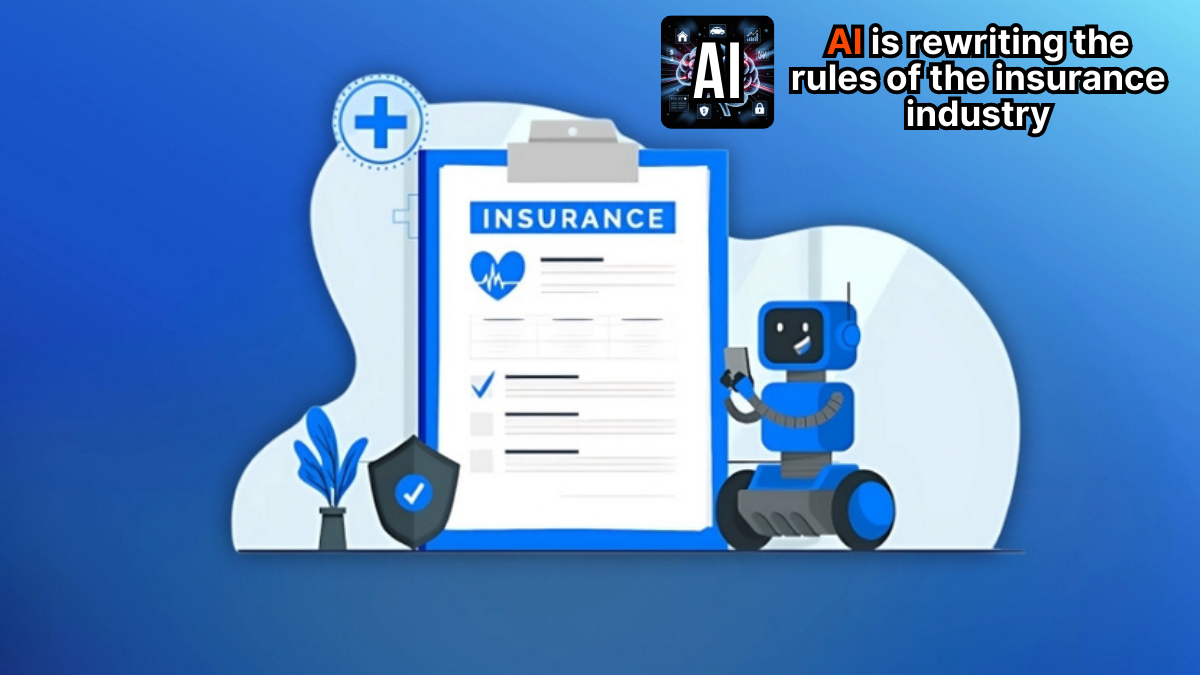The insurance industry, long known for its cautious approach to change, is experiencing a revolution driven by artificial intelligence. With the potential to add $1.1 trillion in annual value, AI is reshaping how insurers operate, serve customers, and manage risk.
While nearly 80% of insurance companies are experimenting with AI technologies, a similar percentage report that these investments haven’t yet translated into increased profitability. This gap reveals a critical truth: successful AI implementation requires more than just adopting new technology but it demands fundamental changes in how insurance companies operate.

This comprehensive guide explores how AI is transforming the insurance landscape, from lightning-fast claims processing to personalized customer experiences, and what it means for the future of the industry.
The Claims Revolution: From Weeks to Seconds
The most dramatic transformation is happening in claims processing, traditionally one of the most time-consuming aspects of insurance operations.
Speed That Defies Expectations
New York-based insurer Lemonade achieved a breakthrough in 2021 by settling over one-third of its claims in just three seconds—with zero human intervention. Similarly, a major US travel insurer handling 400,000 claims annually transformed from a completely manual system to 57% automation, reducing processing times from weeks to minutes.
These aren’t isolated success stories. AI-powered claims processing is becoming the new standard because it delivers measurable results:
- Reduced processing time: From weeks to minutes or seconds
- Decreased human error: Up to 30% reduction in claims leakage
- Increased productivity: Adjusters can handle 40-50% more cases
Enhanced Accuracy and Fraud Detection
AI systems excel at pattern recognition, making them incredibly effective at identifying fraudulent claims. By analyzing vast amounts of data and comparing it against historical patterns, AI can spot anomalies that human reviewers might miss.
Insurance companies using AI for fraud detection report up to 40% reduction in fraud-related losses. This protection benefits both insurers and honest policyholders by keeping premiums more affordable.
Freeing Human Expertise for Complex Cases
Rather than replacing human adjusters, AI handles routine claims processing, allowing experienced professionals to focus on complex cases requiring empathy, negotiation skills, and nuanced judgment. This division of labor maximizes both efficiency and customer satisfaction.
Underwriting Gets Smarter: Risk Assessment in Real-Time
Traditional underwriting relied heavily on historical data and manual analysis. AI is transforming this process by enabling real-time risk assessment using diverse data sources.
Comprehensive Data Analysis
Modern AI systems can analyze information from multiple sources simultaneously:
- Telematics data for auto insurance
- IoT sensors for property insurance
- Social media activity for lifestyle assessment
- Credit scores and financial history
- Satellite imagery for property evaluation
Precision Pricing
Zurich Insurance used AI-powered risk management tools to improve their assessment accuracy by 90%. This level of precision allows insurers to offer fairer pricing that reflects individual risk profiles rather than broad demographic categories.
Proactive Risk Management
AI enables insurers to move beyond reactive coverage to proactive risk prevention. By identifying potential risks before they materialize, insurers can work with clients to implement preventive measures, reducing claims and improving safety.
Customer Experience: Personal and Proactive
The customer experience in insurance is being revolutionized through AI-powered personalization and proactive service.
24/7 Intelligent Support
AI chatbots now provide round-the-clock customer support, becoming more sophisticated with each interaction. These systems can:
- Answer policy questions instantly
- Guide customers through claims processes
- Provide personalized recommendations
- Escalate complex issues to human agents
Personalized Products and Services
AI analyzes customer behavior, preferences, and life events to offer relevant products and services. For example, usage-based auto insurance adjusts premiums based on actual driving behavior rather than demographic assumptions.
Proactive Communication
Instead of waiting for customers to reach out, AI systems can proactively communicate important information:
- Renewal reminders with personalized offers
- Weather alerts for property owners
- Safety tips based on individual risk profiles
- Policy optimization suggestions
The Low-Code Revolution: Democratizing Innovation
Low-code platforms are accelerating AI adoption in insurance by making technology accessible to business users without extensive programming knowledge.
Faster Development and Deployment
Low-code platforms enable insurance companies to:
- Build custom applications quickly
- Adapt to changing market conditions
- Launch new products faster
- Iterate based on customer feedback
Citizen Development
These platforms empower business users often called “citizen developers” to create solutions for their specific needs without relying entirely on IT departments. This democratization of development accelerates innovation while maintaining security and compliance standards.
Maintaining Security and Compliance
Modern low-code platforms include robust security features and compliance controls, ensuring that rapid development doesn’t compromise regulatory requirements because its crucial for the heavily regulated insurance industry.
Market Impact and Financial Returns
The numbers tell a compelling story about AI’s impact on the insurance industry.
Market Growth Projections
The AI insurance market is expected to reach over $14 billion by 2034, representing explosive growth driven by proven results and expanding capabilities.
Measurable Business Benefits
Early AI adopters in insurance are seeing significant returns:
- 14% increase in customer retention
- 48% improvement in Net Promoter Scores
- 30% reduction in operational costs
- 40% decrease in fraud losses
Customer Satisfaction Improvements
AI addresses long-standing customer pain points in insurance:
- Faster claim settlements (addressing the 60% of customers who blame slow settlements for dissatisfaction)
- More personalized service
- Proactive communication
- Transparent processes
Implementation Challenges and Solutions
Despite the clear benefits, insurance companies face several challenges when implementing AI.
Data Integration Issues
Many insurers struggle with data stored in legacy systems that don’t communicate effectively. Solutions include:
- Data modernization initiatives
- API-first architecture
- Cloud migration strategies
- Data governance frameworks
Cultural Resistance
Traditional insurance culture can resist technological change. Successful implementation requires:
- Leadership commitment from the top
- Change management programs
- Employee training and reskilling
- Clear communication about AI benefits
Regulatory Compliance
Insurance is heavily regulated, and AI implementation must comply with various requirements:
- Explainable AI for regulatory transparency
- Bias detection and mitigation
- Data privacy protection
- Audit trails for decision-making processes
The Future of AI in Insurance
Looking ahead, several trends will shape the continued evolution of AI in insurance.
Advanced Predictive Analytics
AI will become increasingly sophisticated at predicting risks and customer behavior, enabling:
- Dynamic pricing that adjusts in real-time
- Predictive maintenance for insured assets
- Behavioral interventions to prevent claims
- Personalized policy recommendations
Integration with Emerging Technologies
AI will increasingly integrate with other technologies:
- Internet of Things (IoT) for real-time monitoring
- Blockchain for transparent claims processing
- Autonomous vehicles for transportation insurance
- Climate modeling for environmental risk assessment
Regulatory Evolution
Regulatory frameworks will evolve to address AI-specific concerns while enabling innovation:
- AI governance standards
- Algorithmic transparency requirements
- Consumer protection measures
- Industry best practices
Making AI Work: Strategic Implementation
Success with AI in insurance requires a strategic approach that goes beyond technology adoption.
Leadership and Vision
Successful AI implementation starts with clear leadership commitment and a comprehensive vision for how AI will transform the organization.
Pilot Programs and Gradual Rollout
Rather than attempting company-wide transformation immediately, successful insurers typically:
- Start with pilot programs in specific areas
- Measure results and refine approaches
- Gradually expand successful initiatives
- Learn from early implementations
Employee Development
Investing in employee training and development ensures that human workers can effectively collaborate with AI systems rather than being replaced by them.
Customer-Centric Focus
The most successful AI implementations focus on improving customer experience rather than just reducing costs or increasing efficiency.
Your Next Steps in the AI Insurance Revolution
The transformation of insurance through AI is not a distant future possibility but it’s happening now. Companies that embrace this change strategically will gain significant competitive advantages, while those that delay risk being left behind.
The evidence is clear: AI offers unprecedented opportunities to improve efficiency, enhance customer experience, and create new value propositions in insurance. The question isn’t whether to adopt AI, but how to do it effectively.
Whether you’re an insurance professional looking to understand these changes or a business leader considering AI implementation, the time to act is now. The $1.1 trillion opportunity awaits those bold enough to seize it.
FAQs About AI in Insurance
1. How is AI used in insurance?
A. AI is used in various areas of insurance, such as automating claims processing, improving underwriting accuracy, detecting fraud, and delivering personalized customer experiences through chatbots and predictive analytics.
2. What are the benefits of AI in the insurance industry?
A. AI enhances efficiency, reduces operational costs, improves risk assessment accuracy, and elevates customer satisfaction with faster and more tailored services.
3. Can AI help detect insurance fraud?
A. Yes, AI can analyze vast amounts of data to identify patterns and anomalies that may indicate fraudulent activity. This allows insurers to proactively address potential fraud.
4. Will AI replace human jobs in insurance?
A. AI is expected to transform roles rather than replace them entirely. While repetitive tasks may be automated, human expertise will remain essential for complex decision-making and customer relationships.
5. How can companies prepare for AI adoption in insurance?
A. Companies can start by assessing their current processes, investing in AI technologies, and training employees to work alongside AI tools to maximize their potential.
6. Is AI adoption expensive for insurers?
A. While initial investment in AI technology may be significant, the long-term savings from increased efficiency, fraud reduction, and enhanced customer retention typically outweigh the costs.
For More Information Click HERE









